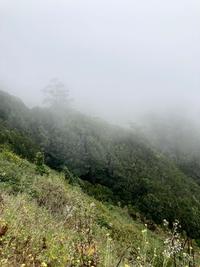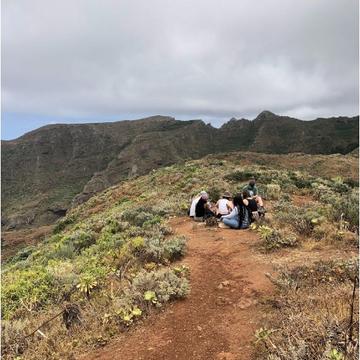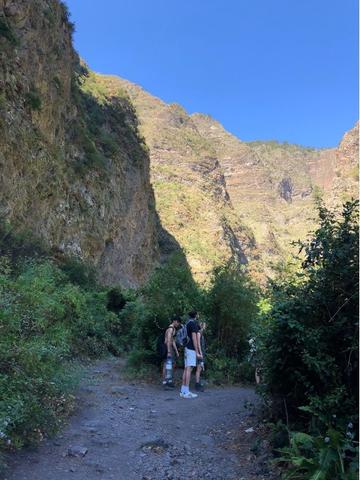After a 13-hour travel day, myself and around 20 other biologists finally found ourselves at the sunny airport of Puerto de la Cruz in Tenerife. As we piled into the poorly air-conditioned minibuses ready for the last stretch of travelling to get to our hotel, we speculated excitedly over what the week ahead would hold – and weren’t disappointed! With a focus on plant biodiversity on an oceanic island, but still plenty of time to explore the town and beaches in the evening, this was a week that I am sure none of us will forget.

Our first day took us to Las Portelas, where we, thankfully, stripped botany back to the basics. After learning how to tell a stamen from a carpel, and petal from a sepal (or even a tepal when things get more confusing!), plus more leaf types than anyone thought possible, we were sufficiently equipped with the knowledge to be able to describe the main features of 15 plants that were selected for us. Not only did this set us up for the week ahead, but it also gave us amazing views and the slightly mystical experience of being completely surrounded by clouds.
Day two presented us with the very different vegetation of Chinamada, where we were able to soak up the sun and spectacular sea views. Our focus switched to interpreting and writing the floral formula, which is a quick and easy way to represent the structure of a flower – a vital tool in any botanist’s toolkit. We wrote the floral formula for more flowers, some hard to reach, and with the help of our hand lenses and razor blades, became absorbed in the task. It was extremely satisfying to gain a new skill that we were able to immediately apply, and it made a nice change to the usual learning behind a laptop in a dark lecture theatre!

On the third day we took the cable car up Mount Teide and walked along the various trails, enjoying the views from above the sea of clouds. As became a theme of our ‘no botany days’ we still made the most of the plant diversity and were excited to see the Teide violet, Viola cheiranthifolia, which only blossoms for three weeks a year and is endemic to the stony caldera. At roughly 3,500 metres, we could feel the higher altitude when we ran back to the cable car to catch our slot back down; missing it would have landed us with a 6-hour hike! After the volcano visit, we spent some time in a botanical garden filled with as many Echium wildpretti that you could want, plus perhaps too many lizards that were not at all reserved when it came to trying to scrounge off our lunch! We had a quick look around a Teide museum, which included a short video describing the formation of Teide and Tenerife as a whole. We took the opportunity of being at the highest point of the island to drive back through all the different vegetation types, allowing us to see how the biomes changed with the altitude. This included stopping in the Coronal Pine Forest, where we caught a glimpse of the endemic Blue Chaffinch, and the ‘bad lands of Guimar’, which was filled with Euphorbiaceae, the sap of which can cause photodermatitis if it gets on your skin. This was definitely my favourite day as we got to see the widest range of different habitat types and gain a real appreciation for the rapid change in ecosystems that comes with the changing elevation.
On the fourth day, we found ourselves in the beautiful ravine of Barranco de Badajoz, where we had a very hot 30-minute hike through the beautiful scenery to get to our base point of the day. This day was dedicated to navigating the highly comprehensive key to the vascular plant species of Tenerife, allowing us to determine an Asteraceae from a Calyceraceae, and identify a wide range of plants to the level of the species. At the end of the day, we were asked to imagine how we would have got on if we tried to do this task just three days before, and it is safe to say we would have hugely struggled. In a similar fashion, the next day was spent in the laurel forest where we were given a much shorter but equally useful key to help us identify different species of trees. With all the practice we had the previous day, we were able to identify them all relatively quickly, giving us the confidence that we were definitely honing our botanical skills!

The final day was another no botany day, where we explored the incredible botanical garden just metres from our hotel, and then had a guided tour of the banana plantation (plus free tasters of the banana liquor, a bottle of which is now on my shelf back at home!). It was interesting to learn that the banana plantation recently switched to becoming completely organic, and we were able to ask the owners about the positive and negative impacts that this switch had brought.
At the end of each day, we had a short lecture to summarise what we had learnt, plus give us more detailed information on some of the topics that we may want to look into for our research project. This still left plenty of time in the evenings for us to explore the local food (the Canarian potatoes with mojo sauce are a must try!), go snorkelling to catch a glimpse of the elusive octopus at La Playa de Muelle, and relax on the hot black sandy beaches.
Overall, the trip was a great opportunity to learn in a more hands-on way, with the satisfaction of applying all we had learned in the lectures to work in the field. We gained a broad scope of knowledge in plant diversity and identification, and I’m excited to apply what we learnt to my research project!